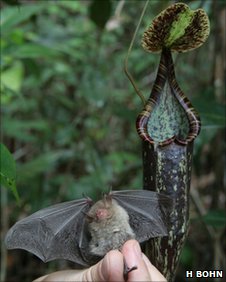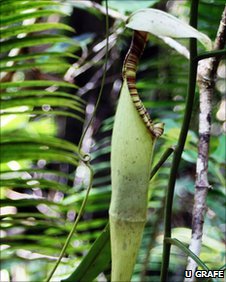It's no load of crap—a carnivorous plant in Borneo survives mostly off of bat feces, a new study says.
A type of Hardwicke's woolly bat and a subspecies of the Nepenthes rafflesiana pitcher plant have developed a mutually beneficial relationship in Brunei, a tiny country that's part of the Southeast Asian island of Borneo.
The bat gets protection by roosting in the plant's rounded leaves, while the plant—which also traps insects—gains vital nutrients from the mammal's droppings.
"This was a most unexpected and surprising result," study leader T. Ulmar Grafe, a scientist at University Brunei Darussalam, said in an email.

"Killer" Plants Feeding on Bat Feces
N. rafflesiana's alluring nectar tricks insects into falling into the plant's vase-like leaf. Prevented from escaping by the leaf's waxy interior, the victim is slowly digested by enzymes at the bottom of the pitcher, according to Iowa State University.
One of Grafe's students first stumbled upon a bat inside the tree-dwelling N. rafflesiana elongata while conducting other research in a peat swamp.
"We extracted [the bat] and it was alive and well, obviously having had a nap within the pitcher until we disturbed it," Grafe said.
To find out if the bat and plant were mooching off each other, Grafe and colleagues caught wild bats and fixed temporary transmitters onto their backs.
The team released the animals back into the wild and observed which pitcher plants the mammals chose as roosts.
The scientists then compared the amounts of nitrogen found in those pitcher plants with levels in unoccupied control plants, also members of the N. rafflesiana species.
Plants visited by bats had much more nitrogen in their leaves than control plants. In fact, bat feces can contribute at least 34 percent of the pitcher plant's nutrient needs, according to the study, published online January 26 in the journal Biology Letters.
"Although we anticipated that bats might benefit the pitcher plant in some way," Grafe said, "we were surprised to find such a high percentage of nitrogen derived from feces in the leaf blades of the pitcher plant."
Pitcher "Toilets" Used by Other Species
Because N. rafflesiana lives in trees, this pitcher plant species has more difficulty catching insects than its grounded counterparts, according to the study.
N. rafflesiana elongata has pitchers that are up to four times longer than other varieties but at least seven times less effective at catching insects, Grafe noted.
The longer pitcher is bat-friendly, as it's big enough to stack two of the 1.6-inch-long (4-centimeter-long) bats. More importantly, Grafe said, this kind of pitcher plant has both less digestive fluid than other types and a "girdle" that prevents a bat from sliding down into the fluid.
Instead, bat feces may provide the plant with a superior method for survival, he said.
Such a relationship—which likely evolved independently—seems to be restricted to Brunei and to this one bat and pitcher plant pair.
Even so, feces-fed plants are not completely unheard of, Grafe noted: "Using pitchers as toilets is also known for tree shrews in mountain areas of Borneo."

Source: http://news.nationalgeographic.com/news/2011/110202-bats-feces-carnivorous-plants-toilets-animals-science/


